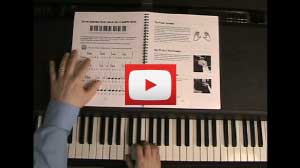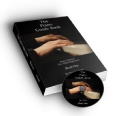Boogie Woogie Pianists
Albert Ammons, Meade "Lux" Lewis, Pete Johnson, Piano Red
Three of the boogie woogie pianists profiled below created a boogie piano craze that started in 1938, and swept across America. The craze lasted for nearly 20 years until the emergence of a new music heavily influenced by boogie piano: Rock and Roll.
Though boogie piano was popular before '38; a concert at Carnegie Hall in that year promoted by music mogul John Hammond ignited the craze. One concert, of the "From Spirituals To Swing" series featured boogie woogie pianists Albert Ammons, Meade Lux Lewis, and Pete Johnson. From this success, the three pianists secured a gig at the popular New York night spot Cafe Society, performing on 3 pianos to a packed club nightly.
Soon boogie woogie was heard in swing music, jump blues, country and later rock and roll.
Albert Ammons, 1907-1949
Albert Ammons was born in Chicago, and both of his parents were pianists. Albert started playing piano at age 10, and by the end of WWI Albert was performing in Chicago Clubs. He was inspired to play boogie and blues by Hersal Thomas and Jimmy Yancey.
In the 1920's he worked with another boogie woogie pianist, Meade Lux Lewis, as a double piano act. Ammons formed a band called The Rhythm Kings in 1934, which had a huge hit with "Swanee River," selling over 1 million copies.
In 1938, Ammons and Lewis teamed with Pete Johnson to perform at the Spirituals to Swing Concert at Carnegie Hall, leading to a long stay at the Cafe Society nightclub. Guest musicians were a regular occurance, including Benny Goodman, Harry James, and others.
In 1944 Albert appeared in the movie Boogie Woogie Dream and in 1949, Ammons played for President Harry Truman's Inauguration. He died later that year in Chicago.
Meade "Lux" Lewis, 1905-1964
Meade "Lux" Lewis was born in Louisville, Kentucky. Though he is one of the most famous boogie woogie pianists, not much is known of his early days. Lewis claimed Jimmy Yancey as an early influence on his piano playing.
He had a huge hit in 1927 with "Honky Tonk Train Blues" on Paramount Records. He worked as a duo piano act with Albert Ammons(above) through the 20's, and in 1938 their Carnegie Hall concert sparked a boogie woogie craze.
The groundbreaking jazz label Blue Note Records was originally formed in 1939 to record and release a Meade "Lux" Lewis record. He continued making records well into the 1950's and has been regarded as one of the true original boogie woogie pianists. Lewis died in Minneapolis, Minnesota in an automobile accident.
Pete Johnson, 1904-1967
Pete Johnson, from Kansas City, MO, moved to New York in 1922 and first worked as a drummer before switching to piano in 1926. He played clubs and rent parties, building a powerful right hand and a steady left. He accompanied Kansas City blues shouter Joe Turner on many of his original records including "Roll 'Em Pete," and "Cherry Red." He Teamed with Ammons and Lewis in 1938 for the Carnegie Hall Concert and Cafe Society gigs.
In the 40's he recorded "Rocket 88 Boogie," the inspiration for Ike Turner on the Jackie Brenson song "Rocket 88," considered by some to be the "first" rock and roll record. Also in the late 40's he made what may be the first "concept" album. Called "Pete's House Warming," the album started with Johnson playing solo, the next tune a duo, then trio, building up to a full band, featuring Kansas City musicians.
He settled in Buffalo, New York, in 1950, and toured with Joe Turner and Jimmy Rushing, another K.C. blues shouter. He died of a stroke in Buffalo.
Clarence "Pinetop" Smith, 1904-1929
Clarence "Pinetop" Smith, from Troy, Alabama, lived a short but influential life. He moved to Birmingham in 1920, then Pittsburgh, working as a vaudeville singer and pianist. He accompanied blues singer Ma Rainey on records and on tour.
In 1928 Smith moved to Chicago and lived in a rooming house that also housed two other boogie woogie pianists, Albert Ammons and Meade "Lux" Lewis. In 1929, Cow Cow Davenport, working as a talent scout, brought him to Vocalion Records. He recorded "Pinetop's Boogie Woogie," which became a huge hit, and also cemented the name "boogie woogie" as the name for this style of music. On his records he would say things like "mess around" and "shake that thing," which would become part of the popular venacular in blues music.
"Pinetop" was scheduled to record a follow up to his hit with Vocalion, but was fatally shot the at a dance hall the night before the recording session.
Piano Red, 1911-1985
Piano Red, born William Lee Perryman in Hampton Geogia, was an albino african-american. His brother, also an albino and a bluesman known as "Speckled Red," was 19 years older. Piano Red was self-taught and heavily influenced by Fats Waller.
In the 1930's, Piano Red worked as a boogie woogie pianist, playing the rent party circuit, touring through the south and recording for Vocalion Records. He was versatile enough to also play white clubs, playing the popular standards of the day. He also toured with travelling blues legends like Barbeque Bob and Blind Willie McTell.
He dopped out of the business in the late 30's, becoming an upholsterer. In 1950, he returned to the music business, signing with RCA. Two songs, "Red's Boogie Woogie" and "Rockin' With Red" became hits, and he started touring again. Later in the '50's he became a disc jockey in Atlanta., known as "Doctor Feelgood," introducing a young James Brown to the world. He also made some records in the 60's as "Dr.Feelgood." In 1966, the folk-rock group The Lovin' Spoonful covered his song "Bald Headed Lena." He finished his career playing in Underground Atlanta. He died from cancer in 1985.
Start Playing Piano Today with the Piano Guide Quick Start Course!
Easy to follow step-by-step lessons designed for adult beginners. The next best thing to private lessons!
What You'll Learn:
- Notes on the piano/keyboard
- Proper fingering
- C major scale
- Chords
- How to read music
- And much more!

Video lessons - watch as I play everything for you.

